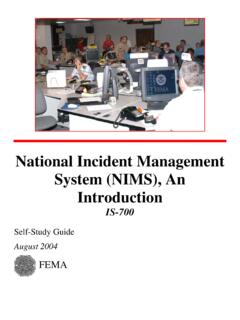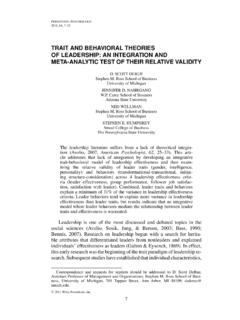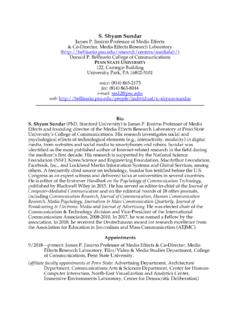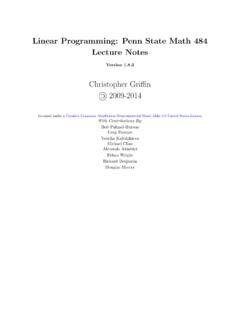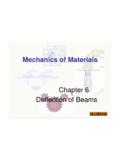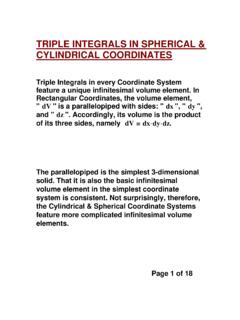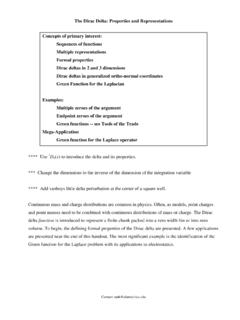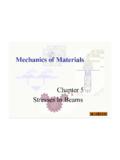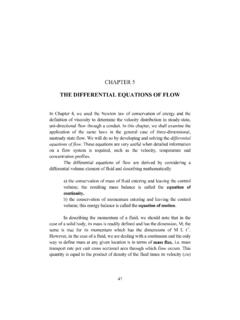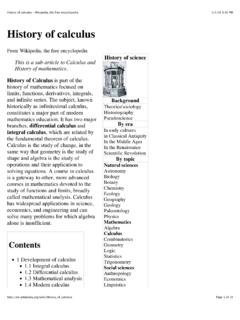Transcription of Chapter 11. Mixed Strategy Nash Equilibrium
1 Chapter 11. Mixed Strategy Nash Equilibrium As we have seen, some games do not have a Nash Equilibrium in pure strategies. However, existence of Nash Equilibrium would follow if we extend this notion to Mixed strategies. All we need is for each player s Mixed Strategy to be a best response to the Mixed strategies of all other players. Example: Matching pennies game. We saw before that this game does not have a Nash Equilibrium in pure strategies. Intuitively: Given the pure conflict nature of the matching pennies game, letting my opponent know for sure which Strategy I will choose is never optimal, since this will give my opponent the ability to hurt me for sure. This is why randomizing is optimal. Consider the following profile of Mixed strategies: and Note that And therefore, Since payoffs are symmetrical, we also have Note that: Each player is indifferentbetween his two strategies (H or T) if the other player randomizes according to (both Hand Tyield a payoff of zero).
2 Both strategies are best responses to . Playing the Mixed Strategy also yields a payoff of zero and therefore is also a best response to . Therefore, if the other player chooses H or T with probability each, then each player is perfectly content with also randomizing between H and T with probability . This constitutes a Nash Equilibrium in Mixed strategies. Definition:Consider a ( Mixed ) Strategy profile where is a Mixed Strategy for player . The profile is a Mixed Strategy Nash equilibriumif and only if playing is a best response to .That is: for each Fact #1 about Mixed Strategy Nash Equilibrium :A Mixed Strategy is is a best response to only if assigns positive probability exclusively to strategies that are best responses to . Facts about Mixed Strategy Nash equilibria:1.
3 In any Mixed Strategy Nash Equilibrium , players assign positive probability only to rationalizable strategies. That is, only if is In any Mixed Strategy Nash Equilibrium , the Mixed Strategy assigns positive probability exclusively to strategies that are best responses to .That is:If , then it must be that: for every .3. In any Mixed Strategy Nash Equilibrium ,each player is indifferentbetween all the strategies that he can play with positive probability according to . That is, for each : for all such that and Using these facts, we can characterize a step by step procedure to find Mixed Strategy Nash equilibria in two player games (things get a bit more complicated in games with three or more players). Procedure for finding Mixed Strategy equilibria in discrete, two player games:1.
4 Step 1: Find the set of rationalizablestrategies in the game using iterated dominance. 2. Step 2: Restricting attention to rationalizablestrategies, write equations for each player to characterize mixing distributions that make each player indifferent between the relevant pure Step 3: Solve these equations to determine Equilibrium mixing distributions. Example: A lobbying game. Suppose two firms simultaneously and independently decide whether to lobby (L) or not lobby (N) the government in hopes of trying to generate favorable legislation. Suppose payoffs are: This game has two pure Strategy Nash equilibria: Question:Does it also have a Mixed Strategy Nash Equilibrium ? Since this game has only two players and two strategies, this question is easy to answer. Step 1:Note that both strategies are rationalizable for each player.
5 Step 2:With only two players and two strategies, a profile of Mixed strategies is a Nash Equilibrium if and only if:I. Player 1 is indifferent between L and N when player 2 uses .II. Player 2 is indifferent between L and N when player 1 uses . That is, if and only if are such that: and Since each player has only two strategies (L and N), any Mixed Strategy is fully described by Therefore, In any Mixed Strategy Nash Equilibrium , we must have . That is: This will be satisfied if: And we also must have . That is: This will be satisfied if: Therefore, this game has a Mixed Strategy Equilibrium , where: and This example also illustrates that some games may have Nash equilibria in pure strategies AND also in Mixed strategies. Example: A tennis service game.
6 Consider two tennis players. Player 1 (the server) must decide whether to serve to the opponent s forehand (F), center (C) or backhand (B). Simultaneously, Player 2 (the receiver) must decide whether to favor the forehand, center of backhand side. Suppose payoffs are given by: We begin by noting that this game does not have any pure Strategy Nash Equilibrium . To see why, note that best responses are given by: So there is no pair of mutual best responses in pure strategies. Question:Find the Mixed Strategy Nash equilibria in this game. Step 1:Using iterated dominance, find the set of rationalizable strategies R. To find the reduced game Note first that all three strategies are best responses for player 2, so they will all survive. For player 1, are best responses. And we can show easily that is dominated by a Mixed Strategy between.
7 From here, we have: ( ) To find , we note that in the reduced game , the only dominated Strategy is , for player 2. Player 1 does not have any dominated Strategy in . Therefore, It is easy to verify that there are no dominated strategies in . Therefore the game cannot be reduced any further and we have The set of rationalizable strategies is: To find Mixed Strategy Nash equilibria, we need to look for mixing distributions: (where each player randomizes only between C and B and play F with zero probability) such that both players are indifferent between C and , 53, 2B3, 22,312 That is, we must have: and Expected payoffs are given by: Therefore, and need to satisfy: and This yields: and Therefore, the Mixed Strategy Nash Equilibrium in this game is given by the mixing distributions: and Example: Find the set of Nash equilibria (pure and Mixed ) in this game: We begin with the pure Strategy equilibria: Mixed Strategy equilibria.
8 First, using iterated dominance we look for the set of rationalizablestrategies R Player 1: M is a best response to X and Y , while U is a best response to Z . The Strategy D is dominated by U . Player 2: Z is a best response to U , X is a best response to M and D . We need to check if Y is a dominated Strategy . Same procedure we followed in Chapter 6 shows that it is NOT a dominated Strategy . Therefore: Matrix form of the reduced game is: Player 1 has no dominated strategies in the reduced game given by . For Player 2, Y is dominated by Z in the reduced game given by . Therefore, .. Reduced game: Player 1 has no dominated strategies in the reduced game given by . Player 2 has no dominated strategies in the reduced game given by . Therefore, no further reduction can be done and we have.
9 Therefore, Focusing on the rationalizable strategies R, we now need to find well defined mixing probabilities such that both players are indifferent between their actions (X and Z for player 2, and U and M for player 1). That is: and The reduced game R looks like this: From here we have: And: XZU2, 04, 2M3, 42,312 Both players will be indifferent between their relevant strategies if and only if: (for player 1) (for player 2) The first condition will hold if and only if And the second condition will hold if and only if Therefore, this game has one Mixed Strategy Nash Equilibrium where players randomize according to the distributions: Mixed Strategy Nash Equilibrium in Continuous Games:As in discrete games, the key feature is that players must randomize in a way that makes other players indifferent between their relevant strategies.
10 Example: Bertrand competition with capacity constraints. Consider a duopoly industry of a homogenous good with two firms who compete in prices. Suppose the market consists of 10 consumers, each of which will purchase one unit of the good. Suppose that each consumer is willing to pay at most $1 for the good. For simplicity, suppose the production cost is zero for both firms. If this setup fully describes the model, then it is a very simple case of Bertrand competition. As we learned previously, the Equilibrium prices would be those that yield a profit of zero. Since production cost is zero, this mean that the Nash Equilibrium prices would be: and as we learned previously, this would be the UNIQUE Nash Equilibrium in the game. Suppose now that both firms have a capacity constraint. Specifically, suppose each firm can produce at most eight units of the good.
